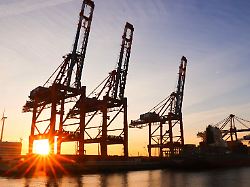Inflation slows recovery
German economy is no longer shrinking
07/28/2023 10:02 am
The German economy is not growing again in the spring. According to an estimate by the Federal Statistical Office, gross domestic product (GDP) stagnated from April to June compared to the first quarter. Before that, it had shrunk for two straight quarters.
The German economy is stuck in the doldrums. After the frosty economic winter, the hoped-for spring upswing failed to materialise. The gross domestic product (GDP) stagnated in the second quarter compared to the previous quarter after price, seasonal and calendar adjustments, as reported by the Federal Statistical Office in Wiesbaden based on preliminary figures. According to economists, the prospects for the coming months have also clouded over.
In the winter half-year, the German economy slipped into a so-called technical, i.e. short-term, recession with two negative quarters in a row. An important reason for this was the high inflation, which above all dampened the willingness of private households to spend and weighed on the economy accordingly. According to preliminary data from the statisticians, consumer spending by private households stabilized in the second quarter after the weak winter half-year.
According to economists, there are increasing signs of a weak second half of 2023. The mood in the German economy deteriorated again in July. The IFO business climate index fell for the third time in a row. “The situation in the German economy is getting darker,” commented IFO President Clemens Fuest. According to DZ Bank economics expert Christoph Swonke, the German economy is being dampened by higher interest rates and persistently high inflation. Added to this is the restrained demand from abroad.
Economy likely to shrink for the year as a whole
Economic research institutes and many bank economists expect that Europe’s largest economy will shrink slightly over the year as a whole. The Deutsche Bundesbank expects economic output to fall by 0.3 percent. The International Monetary Fund (IMF) also recently predicted a drop of 0.3 percent.
GDP shows how well or poorly a country’s economy is developing. Everything that is produced in a certain period of time is included. In addition, the value of services and consumer spending as well as investments by companies – for example in machines – are included. All economic sectors are taken into account. The largest item is private consumption. Another component is the so-called external contribution – i.e. the difference between what companies sell abroad (exports) and buy from there (imports).
